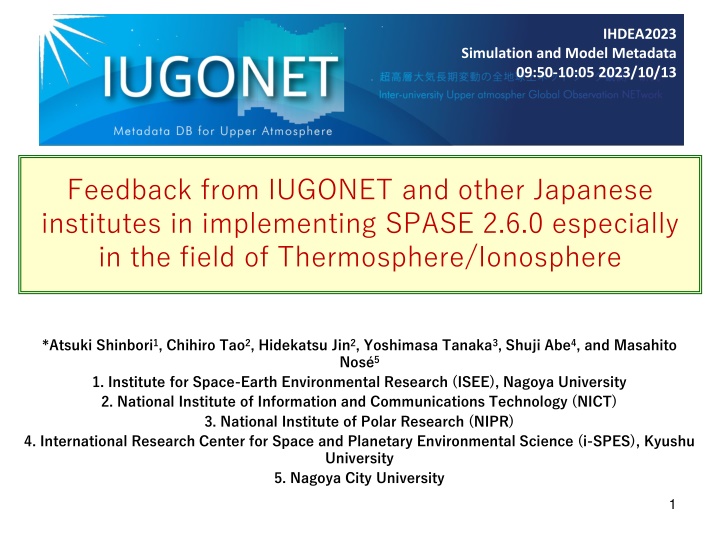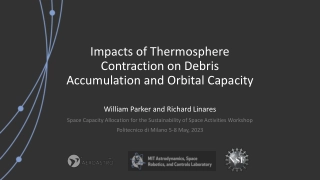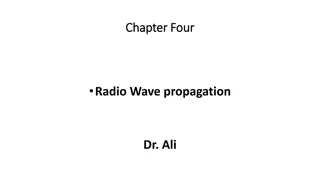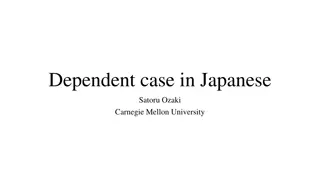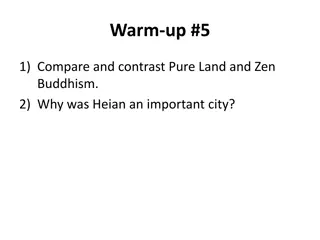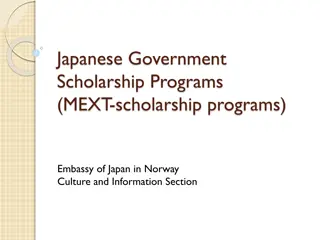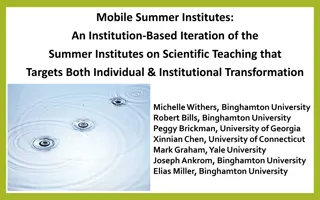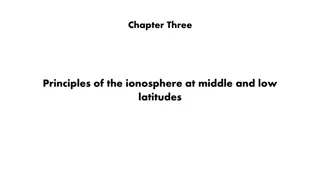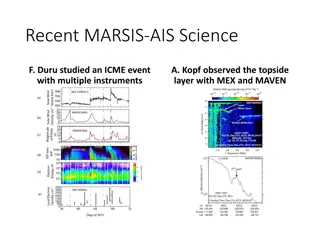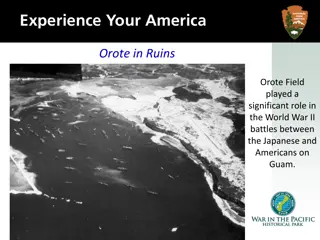Japanese Institutes Implementing SPASE 2.6.0 for Thermosphere/Ionosphere Research
Feedback on implementing SPASE 2.6.0 in the field of Thermosphere/Ionosphere from Japanese institutes including IUGONET. The discussion covers the purpose of the IUGONET project, current status of the metadata databases, the GAIA model, and major scientific results achieved. Input and output data of the GAIA model are also highlighted.
Download Presentation

Please find below an Image/Link to download the presentation.
The content on the website is provided AS IS for your information and personal use only. It may not be sold, licensed, or shared on other websites without obtaining consent from the author.If you encounter any issues during the download, it is possible that the publisher has removed the file from their server.
You are allowed to download the files provided on this website for personal or commercial use, subject to the condition that they are used lawfully. All files are the property of their respective owners.
The content on the website is provided AS IS for your information and personal use only. It may not be sold, licensed, or shared on other websites without obtaining consent from the author.
E N D
Presentation Transcript
IHDEA2023 Simulation and Model Metadata 09:50-10:05 2023/10/13 Feedback from IUGONET and other Japanese institutes in implementing SPASE 2.6.0 especially in the field of Thermosphere/Ionosphere *Atsuki Shinbori1, Chihiro Tao2, Hidekatsu Jin2, Yoshimasa Tanaka3, Shuji Abe4, and Masahito Nos 5 1. Institute for Space-Earth Environmental Research (ISEE), Nagoya University 2. National Institute of Information and Communications Technology (NICT) 3. National Institute of Polar Research (NIPR) 4. International Research Center for Space and Planetary Environmental Science (i-SPES), Kyushu University 5. Nagoya City University 1
1. Introduction 1.1 Purpose of the IUGONET project and coverage of solar- terrestrial physics data The Inter-university Upper atmosphere Global Observation NETwork (IUGONET) project aims at establishing e-infrastructure for researchers to effectively find, get, and analyze various kinds of upper atmospheric data spread over Japanese universities and institutes. To promote solar-terrestrial physics (STP) science To construct an international human network and develop human resource To expand new field researches with a collaboration to data science community The IUGONET project mainly deals with ground-based STP observation data (including some meteoritical data). We now use the SPASE 2.4.0 metadata model and IUGONET extension 2.4.0.1 to operate the IUGONET metadata database. Shinbori+, IHDEA2023, October 13, 2023 2
1. Introduction 1.2 Current status of the IUGONET metadata database and attempt to deal with thermosphere/ionosphere models Current status of the IUGONET metadata database (Type-A) SPASE 2.4.0 + IUGONET2.4.0.1 Ground-based observation data Magnetometer, riometer, camera, radar etc. We added the SpacitalCoverage item as a IUGONET extension. IUGONET Type-A Satellite observation data CHAMP and COSMIC RO data Model data SPASE 2.6.0 Atmospheric/ionospheric model Attempt to extend to simulation data Shinbori+, IHDEA2023, October 13, 2023 3
2. GAIA model 2.1 An overview of the GAIA model The Ground-to-topside model of Atmosphere and Ionosphere for Aeronomy (GAIA) model solves the physical processes of vertical coupling from the Earth's atmosphere to ionosphere. GCM part Coupler part Shinbori+, IHDEA2023, October 13, 2023 4
2. GAIA model 2.2 Major scientific result of the GAIA model The persistent wavenumber 4 structure in the iongitudinal variation can be reproduced by the GAIA model. Plasma physics Upper atmospheric physics Meteorology [Jin et al., 2011] Shinbori+, IHDEA2023, October 13, 2023 5
2. GAIA model 2.3 Input and output data of the GAIA model Input parameters ModelRun InputParameter (SPASE 2.6.0) For upper atmosphere and ionosphere: Solar F10.7 flux, auroral particle precipitation, polar cap potential For lower atmosphere (troposphere): Meteorological reanalysis data (JRA55 or JRA25) ---pressure, wind, temperature JRA25: Japanese 25-year ReAnalysis JRA55: Japanese 55-year ReAnalysis (https://jra.kishou.go.jp/JRA-55/index_en.html) Output parameters NumericalOutput (SPASE 2.6.0) GCM part: wind velocity, pressure, temperature, rain fall precipitation etc. Coupler part: wind velocity, electric field, molecular density etc. Data format: NetCDF (familiar with a meterology field) Shinbori+, IHDEA2023, October 13, 2023 6
3. Feedback to the SPASE 2.6.0 model 3.1 Questions/comments to adopt the SPASE 2.6.0 model to GAIA simulation data (1) Relationship among NumericalOutput, ModelRun, and Model How ModelRun is referred from NumericalOutput? NumericalOuput/InputResoueceID should be used? Model Both ModelRun and Model categories have the same name tag InputResourceID . [Proposal for solution] Model run For ModelRun InputResourceID ModelID For NumericalOuput InputResourceID ModelRunID Shinbori+, IHDEA2023, October 13, 2023 7
3. Feedback to the SPASE 2.6.0 model 3.1 Questions/comments to adopt the SPASE 2.6.0 model to GAIA simulation data (2) Necessity to add some new vocabulary of Model/ModelType , etc. The original vocabulary included in the SPASE 2.6.0 model is defined for simulations of space plasma physics in the heliosphere/magnetosphere In the current version, we cannot comprehensively write the metadata for the GAIA model description and output parameters. Current version Required vocabulary GCM, NonHydrostatic, ElectrostaticHD, IonNeutralFluid, CoupledAtmosphere, etc. Empirical, Hybrid, MHD, PIC, Paraboloid, TestParticle Added in the SPASE model in future Shinbori+, IHDEA2023, October 13, 2023 8
3. Feedback to the SPASE 2.6.0 model 3.1 Questions/comments to adopt the SPASE 2.6.0 model to GAIA simulation data (2) Necessity to add some new vocabulary of Model/ModelType, etc. [Proposal for solution] We send a list of additional terms and their description to the SPASE developer team after discussion with the GAIA developer team as follows. For example, IonNeutralFluid --- A physical model to describe the fluid motion of neutral and ion in partially ionized plasma GCM ---- Mathematical models representing physical processes of the atmosphere and/or ocean NonHydroDynamics --- Mathematical models representing physical processes of the atmosphere and/or ocean, without assuming hydrostatic equilibrium By adding new vocabulary used in other research fields, the SPASE metadata model will be useful for interdisciplinary research data search. Shinbori+, IHDEA2023, October 13, 2023 9
3. Feedback to the SPASE 2.6.0 model 3.1 Questions/comments to adopt the SPASE 2.6.0 model to GAIA simulation data (3) Request to add SpaticalCoverage in the Parameter of the SPASE model The GAIA model is composed of several: atmosphere model, ionosphere model etc. Ionospheric model Time and spatial resolution of the output parameters are different between parameters from different models. Atmospheric model We want to ask the SPASE team to add SpatialCoverage in the next subversion (2.7.0?) of the SPASE model. [Jin et al., 2011] Shinbori+, IHDEA2023, October 13, 2023 10
4. Summary 1. Because GAIA model data are very useful for understanding the physical processes in the Earth's atmosphere and ionosphere, we have tried to create the metadata for the GAIA data and to register them to the IUGONET metadata database. 2. We have three major concerns for the SPASE 2.6.0 model as follows. (1) Relationship among NumericalOutput, ModelRun, and Model (2) Necessity to add some new vocabulary of Model/ModelType, etc. (3) Request to add SpaticalCoverage in the Parameter of the SPASE model 3. We continue to discuss some issues and suggestions to adopt the GAIA model data to the SPASE model and send them to the SPASE developer team. 4. By extending a vocabulary coverage of the SPASE metadata model, it will become a useful tool to promote interdisciplinary studies of geoscience and planetary science. Shinbori+, IHDEA2023, October 13, 2023 11
